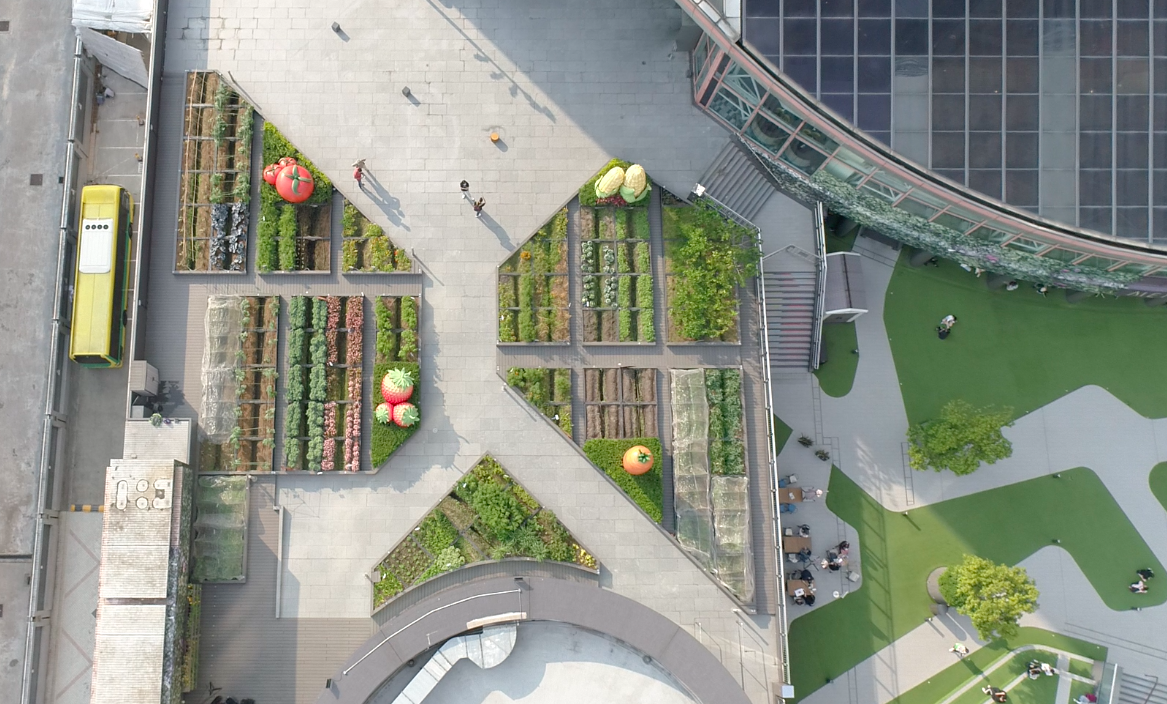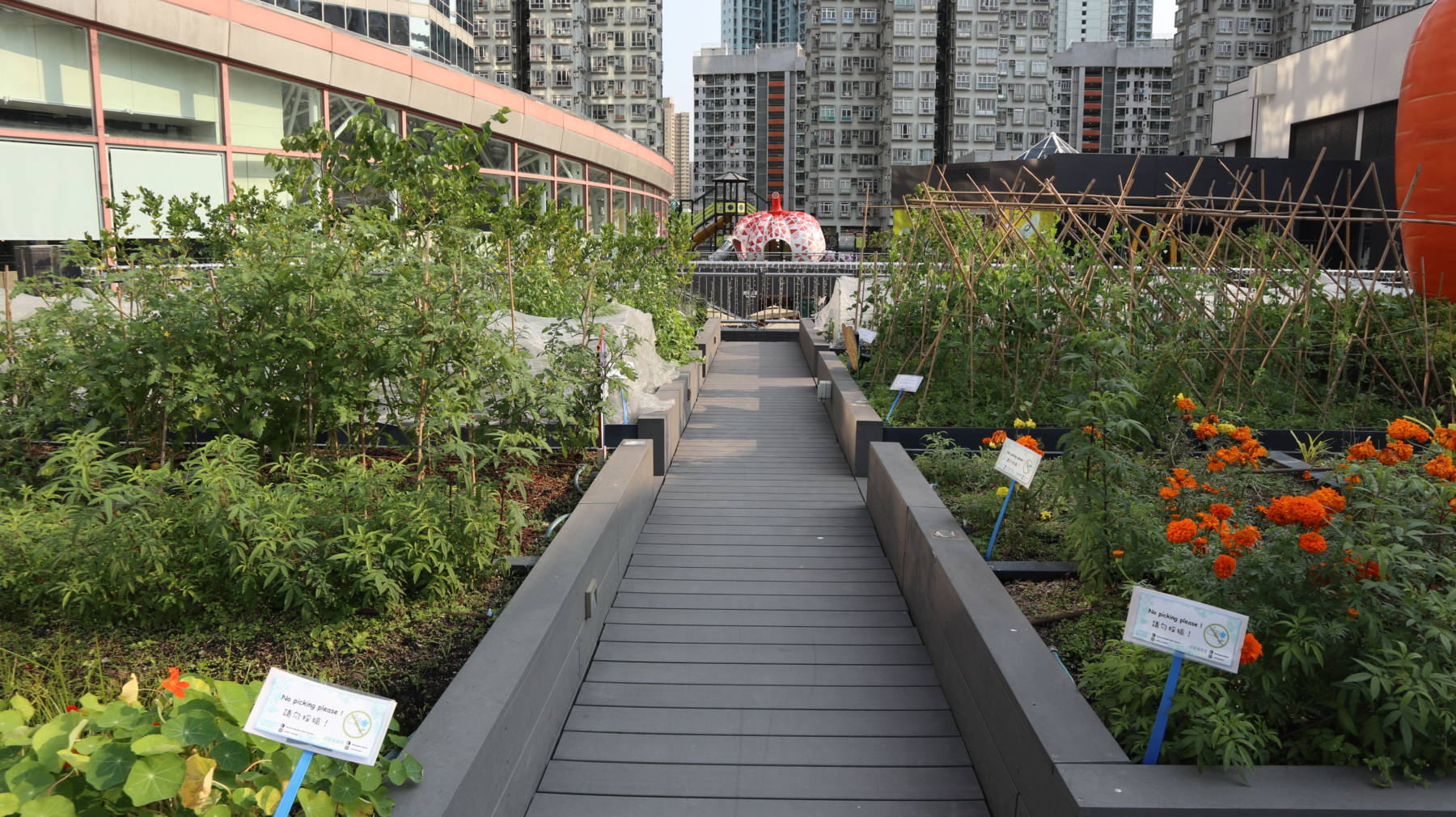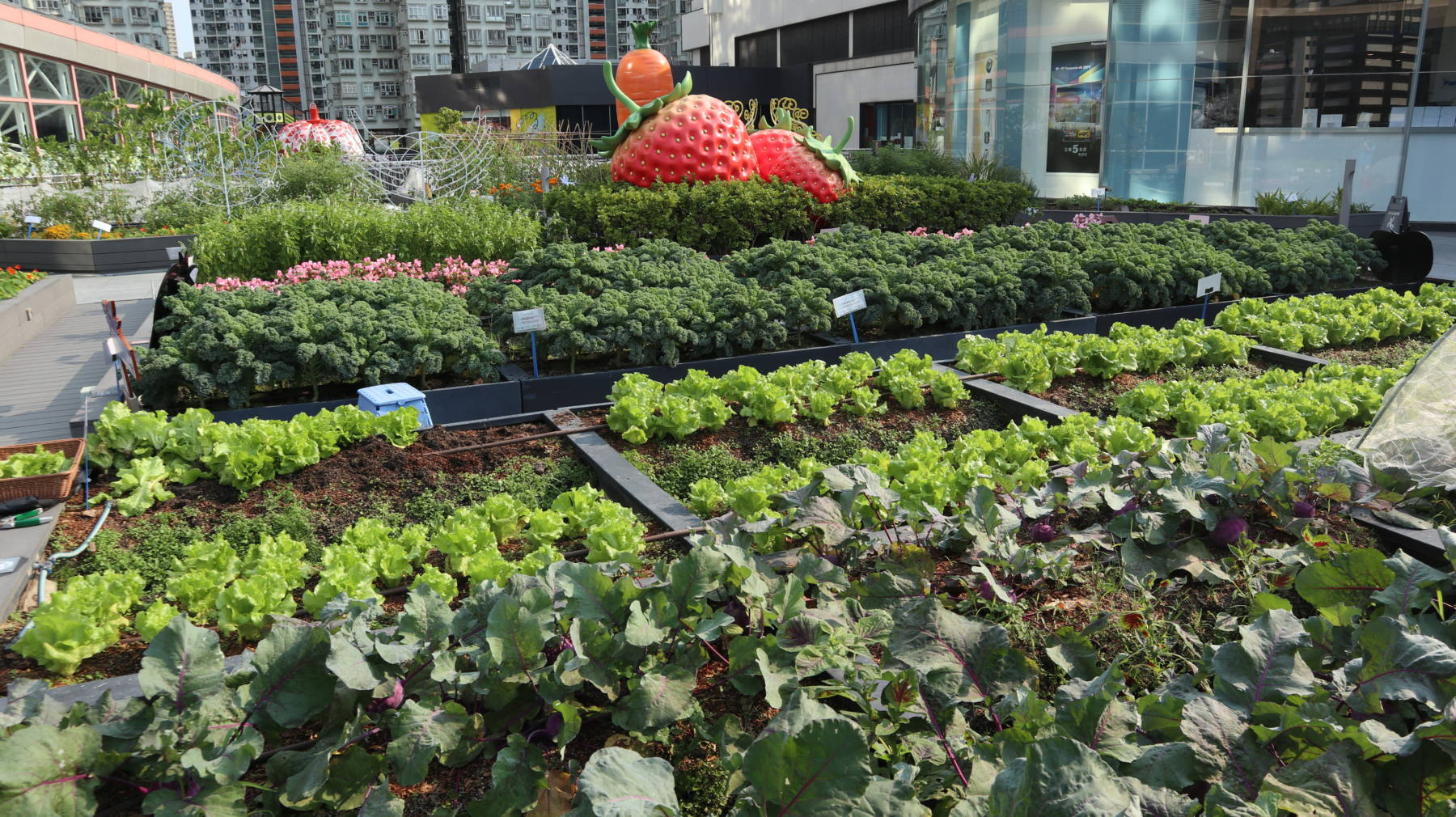Rooftop Republic’s projects are done on a commercial basis, so each project is a careful exploration of the economic returns that can be achieved as well as the opportunities for social experimentation around climate change and health such projects can create.
At Metroplaza, Sun Hung Kai Properties Limited the owner and manager of the mall as well as of the two overlooking office towers was looking for ways to increase overall building value. This meant “enhancing its brand image, improving engagement with visitors and tenants, and increasing footfall,” Tsui explains. “They were planning a mall refurbishment in 2017, and recognised that they had spaces within their property that had major untapped potential. They had an old playground on their roof, which over the years, became less and less visited by families or used by children.”
“So, we began working with them to show how they could transform this space into an urban farm. Unlike a landscape garden which only serves aesthetic purposes, the urban farm would help Metroplaza accomplish more of their motivations for their property revamp.
First, it combined nature and community together. The farm gives the public a green space to explore and relax.
Second, it gives the mall and the rooftop space an interesting story. Unlike a typical landscape garden, the urban farm is more unique and allows the public to interact with nature by observing and smelling all the growing fruits and vegetables.
Third, the farm acts as a natural backdrop for public workshops and events. Since the opening of the Metroplaza farm, the mall has hosted several events that tie in with the urban farming theme, such as our Little Farmers’ Programme where we teach families how to get started with growing their own food, farmers’ markets, and farm tours.”
While some activities are ticketed, like farm-to-table dining events organised in collaboration with the mall’s restaurants, the primary goal of such events is not direct income generation. The goal instead is to drive foot traffic and raise awareness of the farm.
“All of these factors help attract new shoppers and tenants for the shopping mall – especially audiences that are more interested in sustainable living. This in turn helps boost Metroplaza’s brand image and increase mall profitability,” Tsui argues.
The Metroplaza rooftop farm occupies close to a third of what Sun Hung Kai Properties describes as an “outdoor piazza”, which also includes “an al fresco dining area, seasonal flowers with a floral selfie wall, Starlight Walkway, and Fun Park.” The budget for this extensive rooftop refurbishment exceeded $20 million HKD (ie 2.19 million Euros).
Within its 13,000-square feet area, the Sky Garden farm features 3,000 square feet of soil-based growing space, which provide the opportunity to nurture over 30 different species of vegetables and herbs.
As one would expect, the farm’s layout and design account for site constraints, such as the loading capacity of the roof and the amount of sunlight it receives. It also seeks to provide good growing conditions (for example via providing suitable depths in growing beds) for different crops such as perennial edibles that can thrive year-round and vegetables, subject to seasonal rotation.
Given Rooftop Republic’s ambitions in facilitating behavioural change and community building around food, as well as Sun Hung Kai Properties’ expectation for a rooftop attraction that would attract families, young professionals and people interested in sustainable living, design was strongly focused on enabling quality interactions between visitors and the crops. “We knew that this [project] was an important touchpoint for the Hong Kong community to connect with nature and see how food is really grown,” explains Eden Pang, Marketing Manager at Rooftop Republic.
Design implications from this were two-fold: creating opportunities for meaningful individual interactions and providing space where visitors can create relationships with others around a common experience of interacting with the farm and with food. Practically, this translated into ensuring all different cycles of food growth can be seen at all times. It also meant having wide open spaces between sufficiently raised plant beds so that visitors can easily browse the farm and take a close look at what is growing as well as to the explanatory label provided for each crop. All plants are labelled with their common name, origin, use, and a few fun facts about their properties. The farm’s layout also includes larger open spaces that can be used as a community space for performing arts, workshops, and more.
Both the soil and the seedlings used are organic and locally sourced. For seedlings, Rooftop Republic has entered into growing contracts with farmers. This helps enhance plant supply reliability – as explained further below, Hong Kong’s farming and nursery industry is very small, and dominated by family businesses. This approach to plant procurement is also part of Rooftop Republic’s wider Five Gs model, which includes “generating new ecosystems” around healthy food as it ensures the economic returns that stems from the urban farm projects are not just felt in the urban environment where they occur, but also in the surrounding rural communities.
“The farming industry in Hong Kong is small, but as a result is also quite close-knit, and this has helped us form strong relationships with trusted, local farmers. This enables us to work closely with them to place custom seedling orders based on what we need to grow in our urban farms. Different local farmers may also specialize in one type of plant – for example, we prefer to go to one specific farmer for fruit trees, another for edible flowers, and another farmer for seasonal vegetables,” explains Pang.
The downside of this reliance on local farmers is an increased vulnerability to weather-related events. “These small farmers do not have large greenhouses that many industrial-sized seedling producers may have” says Pang. This leaves crop vulnerable to typhoons, which occur twice yearly on the island. “Back in 2018, we experienced Typhoon Mangkhut, which was the strongest storm Hong Kong had seen in decades. This typhoon unfortunately really affected the local farmers and even destroyed thousands of seedlings that they were helping us cultivate at the time.”
The small size of Hong Kong’s farming community also makes it difficult to find skilled farmers to assist with the on-going care of the farm. “We often instead work with retired people looking for new hobbies, or students who are interested in learning about urban farming. We work closely with them and train them up and hire them to work with Rooftop Republic,” explains Pang. In seeking to strengthen the implementation of its Five Gs model, which includes the objective of “grooming the next generation” which means professionalising and building the urban farming sector through hands-on training and employment opportunities, Rooftop Republic has recently launched a Rooftop Republic Academy offering training to participants and volunteers involved in Rooftop Republic’s projects as well as a wider professional and non-professional audience. “We currently employ three farmers at our urban farm at Metroplaza; two of the farmers are local retired people, and one is a hearing-impaired woman who we helped train,” Pang explains.
According to Matthew Pryor, associate professor and head of the Division of Landscape Architecture at the University of Hong Kong there are at least 60 rooftop farms in the city, and possibly many more. The 60 farms identified involve about 1,500 rooftop farmers, cultivating a total area of about one and a half hectares of urban roof space. Based on available information on rooftop conditions and use across Hong Kong, climate data, as well the current very high levels of oversubscription of existing farms (as much as 20 applicants for one place), it is estimated that there is potential for this to easily grow to 50,000 people working on a suitable rooftop areas of 600 hectares, ie nearly five times the size of London’s Hyde Park or twice the size of New York’s Central Park. “Now the total ground level farmable land in Hong Kong is about 420 hectares,” Pryor says. “So, there’s more on the roof than there is on the ground.”
Pryor’s research confirms that the main product of Hong Kong’s rooftop farms isn’t edible. “The rooftop farms here produce virtually nothing compared to Hong Kong’s overall consumption,” Pryor says. “What they do produce, however, is happiness, and this social capital is enormous.”
When surveying participants from different urban rooftop farms in Hong Kong, Pryor found the majority of respondents (77%) perceived social values to be the most important benefits of urban rooftop farming, compared with environmental values (58%) and economic benefits (10%). Within the range of social values highlighted by respondents, personal health, education and recreation came up as the top answers, while wider social communities where also acknowledged.
Pryor highlights the beaming smile of most interviewees when describing their time spent on the rooftop urban farm they frequent. He also describes how for some segments of the Hong Kong society, such as low- or middle-income elderly people, rooftop farms provides a much-needed alternative place to visit to congested streets, in order to find fresh air, social contacts, and things to do.
Although project profile, initiator and physical set up might vary significantly, Pryor points out that it is the ability for urban rooftop farms to deliver valued social benefits that motivates their creation. Pryor’s research has identified three broad categories of urban rooftop farm projects: those initiated by private individuals and community groups, those initiated by charities and those launched by corporations. Private individuals and community groups typically seek access to outdoor space for their own wellbeing and that of others, with opportunities to rent planters. Charities sees urban rooftop farming as an opportunity to fulfil their objectives, whether related to access to food such as for Feeding Hong Kong, facilitating intergenerational activities and supporting ageing in place, such as the Hong Kong Jockey Club, or enabling learning as well as cognitive and emotional development, such as the Caritas Foundation, which runs schools for disabled children. Corporations, such as Sun Hung Kai Properties, see the value urban farms can bring to their business model, in strengthening their sustainability credential and/or providing an area for their workforce to relax, informally meet co-workers and enjoy themselves, all of which can provide a boost to office productivity.
While urban rooftop farms are perceived positively by city planning authorities, “they don’t really know how to describe them or how to codify them,” explains Pryor, “they exist in a grey area in between formal city planning and informal community action.”
Both the city’s New Agricultural Policy, published in 2014, and the Hong Kong 2030+ Strategic Plan acknowledged rooftop farms as playing a significant part in urban agriculture. This, however, is addressed only at a high level, and with an emphasis on productivity and economic output. Once a project takes place, there are no processes in place to facilitate and legitimise their creation. “Rooftop farming exists in an ambiguous area: farm proponents need to negotiate with building owners or management teams, and they may require checks on structural loading etc. There are no performance criteria which would allow them to be formalised within urban land use policies and building control procedures,” Pryor explains. “Projects face significant regulatory hurdles: to transform an idle rooftop into a farm or set up a garden for a new building, one must secure several approvals from the Buildings Department and other government offices, and there is no clear, predefined approval process“.
At Metroplaza, this wasn’t a problem because the creation of the Sky Garden was part of such a large-scale refurbishment, that Sun Hung Kai Properties were prepared to work through the administrative consent needed. But for smaller projects, especially those initiated by charities, Pryor explains that such administrative burden and the uncertainty associated with it is a significant barrier for wider uptake of rooftop urban farming. Building owners are concerned about committing to opening their facilities to a use that, in lack of formal recognition, could face overnight challenge.
An amendment to green roof policy provisions in Hong Kong could address these issues. “Once you do that, I think everybody here will be taking up rooftop urban farming. Hong Kong could be a good model for citywide farming as a social activity,” says Pryor. All municipalities around the world would greatly benefit from ensuring their policies, development management practices and building regulations better measure and proactively facilitate the social health and engagement benefits of rooftop and other urban greening initiatives.



















